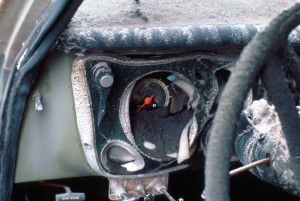For most survivors of Mount St. Helens’s catastrophic lateral blast, the devastation was nearly silent. You would think that a wall of ash, hot gas and rock hurtling at a minimum of 100 kilometers per hour (62 mph), mangling vehicles and ripping down every tree in its path, would be loud, incredibly loud – but only one witness reported hearing much more than a rumbling sound. Some said it sounded “like a freight train,” others that it was similar to a prop plane or jet. Some said the rumbling was loud, a roar: others described it as soft, “barely audible.” This close to the mountain, the cloud seemed to destroy even its own sound. In the debris-laden cloud, “sound was attenuated more than 10,000 times as rapidly as in clear air.” Witnesses described the approaching cloud as a “wall,” and like a wall, it served to mute sounds, leaving no more than an eerie rumble to audibly signal its approach.

It did not look so calm as it sounded.
Within the blast zone, 13 km (8 miles) to the northwest, Charles McNerney watched the black wall approach through a haze of white. A warm breeze ahead of it became wind, then a gale, bending and breaking trees. Charles and his friend quickly realized they needed to flee: they jumped in their car and sped down the road toward Highway 504. Even at speeds up to 121 kilometers per hour (75 mph), they couldn’t outdistance the blast cloud. Heat poured in through the sun roof. Reaching the highway, they accelerated to 137 km/h (85 mph) and finally began putting some distance between themselves and the eruption. After a few miles, they could no longer see the cloud: they stopped, and looked back, and within moments saw the cloud rushing down the North Fork Toutle River valley at speeds of at least 72 km/h (45 mph). Though the white mist, they could see the base of the cloud, “like avalanches of black chalk dust.” They fled again, outracing the cloud at 105 km/h (65 mph).
They survived. They didn’t think those who lingered at the viewpoint longer than they had could have lived.
A few kilometers down Highway 504, at a roadblock with a good view of the mountain, Gil Baker and his friend Kathy Baker watched the eruption begin. As the blast cloud obscured their view of the erupting volcano and cascaded down the valley, they sped west at around 161 km/h (100 mph). Even at that speed, the blast cloud nearly overtook them, “coming down with much authority,” churning and bubbling like “boiling oil with huge bubbles six or more feet in diameter.” After five minutes of frantic driving, they finally outdistanced the cloud and reached safety.

They were the lucky ones. Many people didn’t realize the need to flee until it was too late. Many others didn’t have time to make it to their vehicles and escape. They were caught in the blast cloud, enveloped by it, and in many instances survival hinged on luck.
Dale and Leslie Davis and their friend Al Brooks, 19 kilometers (11 miles) north of the mountain, made it to their pickup before the blast overtook them. The cloud was terrifying in its ferocity. “It looked like a boiling mass of rock – and just as high as you could see,” one of them would later tell USGS geologists. They watched trees being hurled into the air by its leading edge, and when it reached them, huddled in the cab of the truck, they were plunged into a thick, searing-hot darkness. Chunks of material struck the vehicle, sandblasting and denting the side facing the eruption. The heat grew intense enough to melt a styrofoam cooler in the bed. The grill of the truck heated to the point where it softened and deformed. A vent window broke, allowing the intense heat inside: Mr. Brooks suffered burns to his arms, while Mrs. Davis sustained burns to her legs so deep they hadn’t healed three months later. Yet these weren’t the kind of burns one would suffer in a fire: a doctor compared them to microwave burns.

And then the heat was gone. The interior of the windshield became wet, cold enough to make them think the material hitting the truck must now be icy. The cloud lightened, then plunged them into darkness again. Afterward, they would walk out to safety. They would never forget the terror of that morning.
Others, trapped in the open, would have an even more intense experience. Not all of them would survive it.

Previous: The Cataclysm: “That Whole Mountain Range Had Just Exploded.”
Next: The Cataclysm: “I Was Just Instantly Buried.”
References:
Lipman, Peter W., and Mullineaux, Donal R., Editors (1981): The 1980 Eruptions of Mount St. Helens, Washington. U.S. Geological Survey Professional Paper 1250.


This sudden contrast between hot and cold – I have questions about that.
The news article you link to is extremely chilling. Watching a car disappear into the cloud like that… And knowing – knowing – that the people at the roadblock would be gone within a few short minutes… Just chilling.
I wonder about the mechanics of displaced sound, but lack a suitable background to extrapolate on the why of it. Is it possible that some didn’t hear the blast because the debris was propelled forward faster than the speed of sound waves, so that those waves were imprisoned within the debris cloud itself, and thus muffled? Is it possible for a roiling mass of particulates and detritus to actually break sound waves apart or to deflect them? So many questions, so little understanding of physics.
I think that’s essentially what you just said, but I’d love to hear more about the specific physics of how that happens, too.